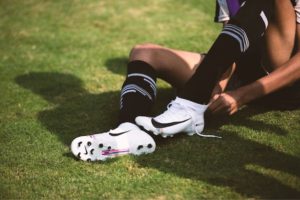Many people believe that regular grass cleats work perfectly fine on turf. It is common for people to compare grass cleats and turf cleats, as it’s crucial to use the appropriate equipment for each situation.

The reason why many sports brands produce different cleats for different fields is that they have other characteristics.
Turf shoes are created to be used on turf and might not give you the same effect as grass cleats on grass. Here are the main differences between grass cleats and turf cleats.
What Are Turf Cleats?
Turf cleats are shoes designed to be used on artificial turf. They sit on the turf and help ensure sufficient friction between your legs and the ground.
Turf cleats lie on top of the turf’s surface without digging into the ground. This is because most artificial turfs stay rigid and compact.
Turf cleats enable players to move around on a turf surface quickly by providing only the required traction you need. You cannot use turf cleats on grass fields, as they will somewhat hinder your movement.
Turf cleats look similar to regular grass cleats. However, the outsoles of the two are different.
What Are Grass Cleats?
Grass cleats are more common than turf cleats. People use grass cleats to play on both grass surfaces and turfs. However, most of the time, people use grass cleats when playing outdoors.
This is because they are created to adapt to different terrains. Grass surfaces can be uneven and unpredictable due to rain.
Various sports brands design grass cleats to withstand slippery floors and muddy grounds. Grass cleats feature long studs underneath that help to grip the floor properly.
This helps the user remain balanced even when slippery grass or the floor is wet.
Differences Between Turf Cleats And Grass Cleats
Turf cleats and grass cleats share various similarities. The differences between the two cleats are few. Grass and turf cleats share a similar upper body structure since that part focuses on comfort.
However, the soles of the two types of cleats are different. The considerable differences between grass and turf cleats include the following.
Turf cleats usually feature outsoles that do not have much grip. This is because turf fields are always consistent and only require a little grip action.
However, grass cleats have outsoles that focus on grip. Most turf cleats have slightly elevated rubber knobs spread out evenly to help provide the grip you need. There are no inch-long spikes like on grass cleats.

Turf cleats provide the best experience on artificial turfs, as they are specially designed for such conditions. You should get turf cleats if you plan on playing on turf. You can use grass cleats on turf, but the performance won’t be as good.
Most grass cleats have around ten hard spikes that provide sufficient grip and balance when playing. The studs are usually made from rubber, plastic, or metal.
However, the knobs on turf cleats are mostly rubber. Grass cleats are all designed to grip the soil and ensure balance, while turf cleats help provide traction.
Most times, you can replace the spikes on grass cleats if you want. It depends on the brand you purchase. However, you can hardly change the knobs on turf cleats. If you damage the knobs, you might have to get new cleats.
1. Soles
The outsole is one of the most significant differences between turf and grass cleats. Grass cleats feature soles with long studs that grip the ground well and provide traction when moving.
The studs on grass cleats can be metal, plastic, or rubber. However, turf cleats do not use metal studs.
The studs on the soles of turf cleats are smaller and not as pointed as that on grass cleats. They mainly comprise rubber soles and only provide the necessary amount of traction. Some turf cleats also have fewer studs than those on grass cleats.
2. Grip And Traction
Another significant difference between turf and grass cleats is the grip and traction. Grass cleats provide sufficient grip to their user.
The reason for this is companies design the studs on grass cleats to pierce into the ground and slide out without any resistance. This helps the user to maintain a steady grip.
The grip of your cleats is essential, as it determines your level of stability. Your efficiency will be protected if you are well-balanced in your cleats. Grassy fields can be a mess when it rains.
The long studs underneath grass cleats help you remain stable when the ground is slippery.
Turf cleats, on the other hand, feature little knobs underneath instead of long studs that provide enough grip for them. The small knobs also help offset the turf’s traction and improve your movement.
If you use grass cleats on turf, traction will increase, but it is still manageable.
Where To Use Turf Cleats

Turf cleats are best suited for use on artificial turfs. Artificial turfs are also known as first-generation artificial grass. Its surface mimics a regular grass field but has fewer shortcomings.
Although a turf field is made to seem like a traditional grass pitch, the playing experience is quite different.
Artificial turfs usually have a hard and even surface with a lot of traction. Hence, it has less cushioning and is unsuitable for grass cleats. Turf surfaces feature little hairs of grass that are shorter than that of a standard grass pitch.
That means it will hurt more if you fall when playing on turf.
You can also get burn marks and nasty scrapes if you slide on the turf. Hence, you will be restricted from making some tackles to avoid injuring yourself. Also, artificial turfs get hot on sunny days.
If you play soccer on turf, it is better to use turf cleats, as they are more appropriate.
Where To Use Grass Cleats
Manufacturers design grass cleats to be great for outdoor use. You can use grass cleats on grass or turfs. However, grass cleats are better suited for grass pitches.
Many stadiums in this age feature artificial grass pitches made using synthetic materials. Grass cleats are perfect for these stadiums.
The artificial grass pitches look similar to regular grass. However, they have slight differences. Artificial grass pitches are more abrasive than natural grass pitches.
This increases your chances of getting burns when you fall. However, it still needs to be more abrasive than turf.
Grass cleats are perfect for both natural and artificial grass pitches. They provide the necessary grip and balance needed for movement. The studs on grass cleats are specially made for use on grass.
Final Thoughts
Wearing the correct set of equipment is essential in any sport. Using the right equipment will give you better results when playing. Turf cleats and grass cleats share many similarities; however, their differences can affect your playing experience.
The significant difference between grass and turf cleats is their soles.
Grass cleats feature long studs that help grip the ground properly, while turf cleats have little rubber knobs on top of the turf surface. The knobs on turf cleats help to reduce traction, so you don’t fall when playing on turf.
Turf cleats are terrible on grass, while grass cleats can work on turfs but not efficiently.

I was working as a mountain guide, probably all around the planet. One day, I met my wife in the mountains, literally on top of the world. Now, I have a beautiful family and three kids, so I don’t have much time for climbing, but sometimes I go camping with my friends. I am also into gym workouts, and I can’t imagine my life without sports.
Since I ended my professional career as a climbing guide, I’ve been giving personal classes and helping amateurs to get ready for conquering their first peaks. Also, that’s how the whole blog idea appeared.





